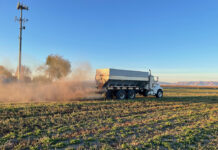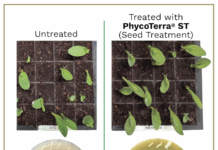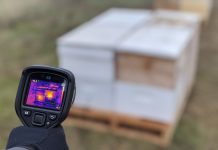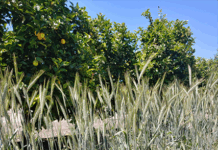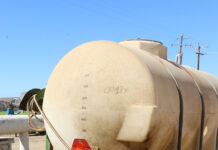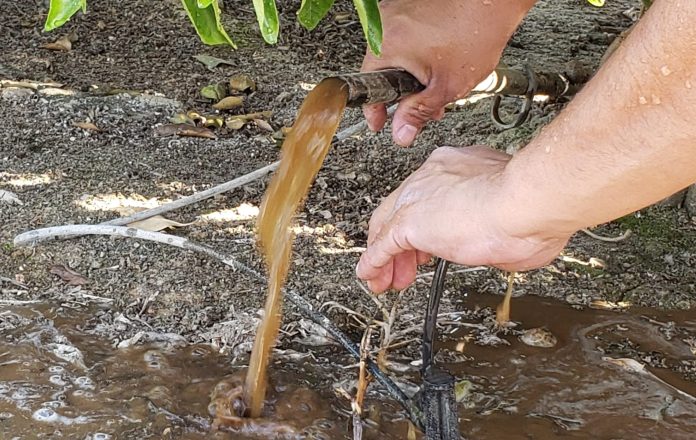
Nut growers are essentially paid in two ways: they can either produce higher yields or reduce the number of deductions from the processor. When nut trees aren’t receiving enough water, you’ll see an increased number of blanks, shriveled kernels and pinched kernels. It’s also common to see more disease and mite activity in the orchard. All of these issues can hurt final nut grade and yield, which ultimately affects grower payouts from the processor.
During this tight water year, it’s more important than ever to help growers implement a science-based approach to reduce the risk of disease and maximize orchard yields. In years of drought, salinity levels in the soil are going to rise, making it critical to keep orchards at proper field capacity so that trees do not suffer from physiological drought stress.
This is not as simple, however, as ensuring the right amount of water is applied to the orchard. Growers are going to be pressured to match water deliveries to crop stage and demands throughout the season, rather than honing in on evapotranspiration (ET) rates.
So the question for CCAs and PCAs is, “How do we help growers implement a strategic irrigation schedule?” My answer starts and ends with measurement. When you ask growers how much water they’re putting out, they often come back with a number of hours irrigated. But this number does not tell you how much water is being applied to an orchard; that can be drastically different based on application rates.
The first step in making the most of irrigation is working with your growers to understand how many inches of water per acre of soil the irrigation system puts out per hour. This piece of information is often overlooked but is essentially the backbone of a good irrigation schedule. Everything else should be calculated based on that application rate. When water is limited, it’s also helpful to know the exact depth of soil that needs to be wetted to avoid overirrigating.

Measuring Orchard Demands
After the exact application rate is determined, growers can start designing an irrigation schedule that meets the needs of their orchards.
Irrigation scheduling maximizes the use of available water by applying the exact amount of water needed to replenish soil moisture. This practice offers growers numerous potential benefits:
- Possibly reduces the grower’s cost of water through more efficiently timed irrigations.
- Lowers fertilizer costs by limiting surface runoff.
- Maximizes net returns by increasing crop yields and crop quality.
- Aids in controlling root zone salinity accumulation through controlled leaching.
- Decreases common disease pressures.
I once worked directly with a walnut grower who was able to increase edible yield by 4% just from having a better understanding of his irrigation output rates and adopting a more scientific irrigation approach. By measuring crop-water demand and optimizing water usage, the grower saw dramatic benefits in nut quality across the board, including both color and size advantages.
There are essentially three approaches to water management, and growers should use at least two of the following to design an irrigation schedule:
Soil-Based Approach
Soil-based methods are simply measuring how much water is being stored in the soil. If there is less water in the soil, and the water is held at a greater tension, it will be more difficult for the trees’ roots to take up that water, resulting in tree stress.
While irrigating based on the feel or appearance of the soil is a commonly used method, more precise measuring tools such as tensiometers, probes and electrical resistance blocks will provide more specific information that growers can utilize to produce healthier, more consistent nut crops.
Like the other approaches mentioned below, soil moisture readings can be used by themselves to schedule irrigations, but they are most beneficial when used in combination with other methods of irrigation scheduling.
Probes, for example, are very good at giving the user a snapshot of what the soil moisture looks like at varying depths. It will determine how deep in the soil profile water is infiltrating and ensure calculated water applications are not over- or under-irrigating trees. However, these probes do not tell you how often or how long to irrigate. Combining the data from the probes with ET measurements on a regular basis will provide enough information to make a strategic irrigation schedule.
Climate-Based Approach
This approach requires a deeper understanding and balancing of irrigation application rates and ET. This is the combination of transpiration, or water evaporation from plant leaves, and evaporation from the soil surface.
Many factors affect ET, including air temperature, humidity and wind speed; soil factors such as texture, structure and density; and plant factors such as plant type, root depth and canopy density, height and stage of growth.
Reference ET information is available from a variety of sources, but most well-known is the California Irrigation Management Information System (CIMIS) network of nearly 100 California weather stations that provide daily ET values.
Knowing how closely the amount of irrigation water plus rainfall matches estimates of real-time orchard ET can help make irrigation scheduling decisions, especially if this information is teamed with other measurement approaches.
Plant-Based Approach
Plants respond in different ways to keep their water supply and demand in balance, and most plant-based methods for irrigation management are based on the measurement of one or more of these responses.
The pressure chamber method for measuring the tension of water within the plant has been shown to be a reliable and commonly used measurement of stress in orchards.
One drawback of using a pressure chamber is that the tool doesn’t distinguish between types of stress. If you are utilizing a pressure chamber in a particularly weak or diseased portion of the orchard, it will not decipher between stress due to poor water supply, salinity and/or pests. This is why it’s important to measure crop-water demands with a climate- or soil-based approach in addition to the pressure chamber approach.
By using ET and a pressure chamber, we found that one almond grower was putting out the right amount of water in the orchard, but the watering interval was too wide. Once the water interval was shortened, trees experienced less stress and were able to produce a much better crop.
I always encourage growers to utilize at least two of the three water management approaches because in the orchard, data or feedback you get from each approach doesn’t always line up perfectly. There’s always some subjectivity. Carefully evaluating the information provided by multiple sources can help determine the best irrigation schedule for your growers’ orchards this year.
Maximizing Irrigation Scheduling ROI
There is not a one-size-fits-all irrigation approach or schedule, and choosing which tools to use depends on water quality available to the grower and operation goals.
Combining a plant-based approach with a climate-based approach has been the most effective in my experience, but there are certainly benefits to monitoring soil moisture status in combination with either of the other two methods .
Companies like Wilbur-Ellis Agribusiness are beginning to offer irrigation scheduling services (Figure 1), that include weekly plant stress readings, soil moisture conditions and watering interval recommendations based on replacement ET.
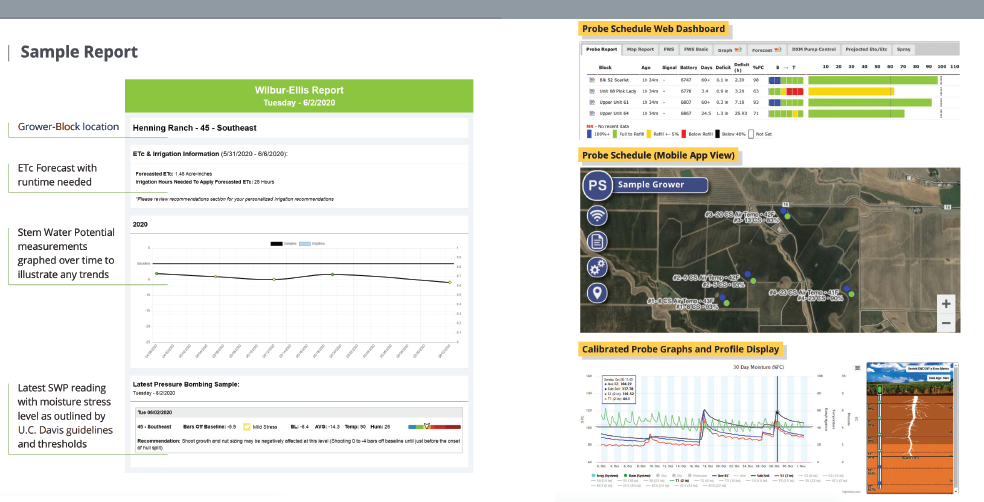
These programs have been shown to reduce drastic swings in irrigation protocols, which in turn reduces pest and disease pressures on orchards. These programs also allow growers to focus on other aspects of irrigation and orchard management rather than worrying about interpreting results.
Another critical piece of irrigation management to keep in mind is system maintenance, which includes in-season flushing. Keeping a clean system with good distribution uniformity is essential when growers are trying to get the most out of orchard irrigation scheduling (Figure 2).
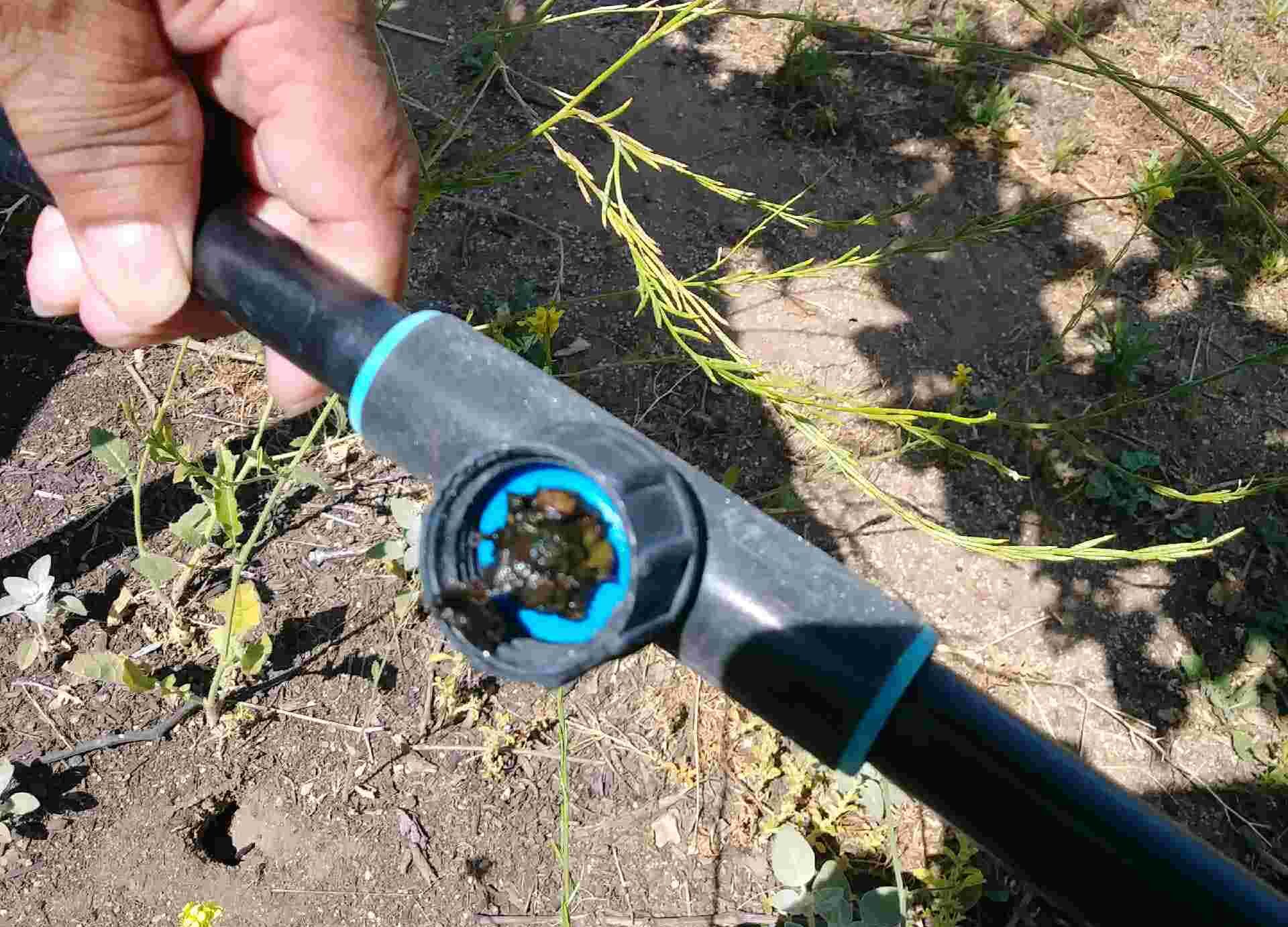
Key In-Season Flushing Protocols
- Regularly flush laterals (monthly, bi-weekly if needed).
- Flush complete system after fertilizer injections.
- Flush from larger to smaller lines; mains and submains, then laterals.
- When flushing lateral lines, ensure proper velocity and volume to purge contaminants.
- Never open more than five to eight laterals at a time, as additional open lines will reduce the velocity of flow, which reduces the effectiveness of the flush (dependent upon the total number of laterals per block).
- Always note pressures and flows at the initial system start-up. Changes in these parameters often indicate in-season issues.


